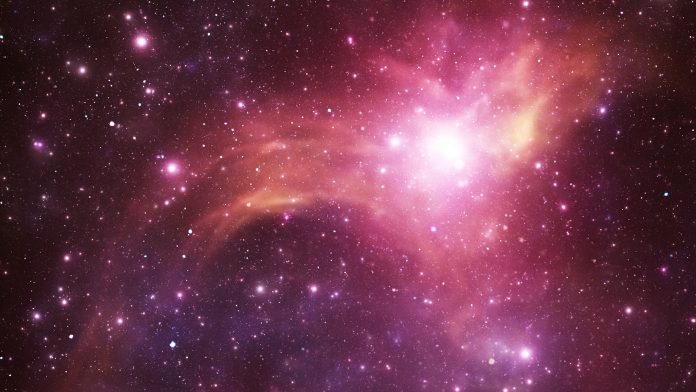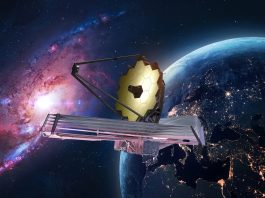Using NASA‘s James Webb Space Telescope, astronomers have made a surprising discovery of a red quasar. Nestled inside the quasar is a cluster of huge galaxies, along with the distributions and motions of gas.
Published in The Astrophysical Journal Letters, the images present new observations from the telescope in multiple wavelengths.
The discovery will expand on our knowledge of how galaxy clusters in the early Universe came together and formed the cosmic web we see today.
Examining the quasar in detail
A red quasar is a special type of active galactic nucleus (AGN), that houses a supermassive black hole at the centre of a galaxy. Gas falling into a supermassive black hole makes the quasar bright enough to outshine all stars in the galaxy.
The quasar explored by Webb is called SDSS J165202.64+172852.3, and has existed for around 11.5 billion years. Unusually, it takes on a red colour because the galaxy’s light has been redshifted by its vast distance. The Webb Telescope was perfectly suited to examining the galaxy in detail because of its unparalleled sensitivity in infrared wavelengths.
This quasar is one of the most powerful known galactic nuclei that has been examined at such an extreme distance. Astronomers had speculated that its extreme emission could cause a galactic wind, pushing free gas out of its host galaxy, and possibly greatly influencing future star formation there.
To investigate the movement of gas, dust, and stellar material in the galaxy, the team used the telescope’s Near Infrared Spectrograph (NIRSpec). This powerful instrument uses a technique known as spectroscopy to examine the movement of various outflows and winds surrounding the red quasar. NIRSpec can simultaneously gather spectra across the telescope’s whole field of view instead of one point at a time, enabling Webb to simultaneously examine the quasar, its galaxy, and the wider surroundings.
The discovery of three new galaxies
Previous studies by NASA’s Hubble Space Telescope, along with other observatories, called attention to the red quasar’s powerful outflows. Astronomers had suspected that its host galaxy could be merging with an unseen partner; however, the team discovered that NIRSpec data was indicating three galaxies, not just one. Due to spectra over a broad area, the motions of all the surrounding material could be mapped, resulting in the conclusion that the red quasar was part of a dense knot of galaxy formation.
“There are few galaxy protoclusters known at this early time. It’s hard to find them, and very few have had time to form since the Big Bang,” said Dominika Wylezalek, an Astronomer at Heidelberg University in Germany, who led the study with Webb. “This may eventually help us understand how galaxies in dense environments evolve. It’s an exciting result.”
Using the NIRSpec observations, the team were able to confirm that the quasar had three galactic companions, as well as show how they were connected. Archival data from the Hubble Telescope hints that there could be many more.
Images from Hubble’s Wide Field Camera 3 have shown extended material surrounding the quasar and its galaxy, which prompted its selection for the study conducted on its outflow and the effects on its host galaxy. Now, the team suspects they could have been looking at the core of a whole cluster of galaxies – only revealed now by the crisp images from the Webb Telescope.
“Our first look at the data quickly revealed clear signs of major interactions between the neighbouring galaxies,” shared Andrey Vayner of Johns Hopkins University in Baltimore, Maryland. “The sensitivity of the NIRSpec instrument was immediately apparent, and it was clear to me that we are in a new era of infrared spectroscopy.”
Are these galaxies the densest in the Universe?
The three confirmed galaxies are orbiting each other at incredibly high speeds, which is an indication that a great deal of mass is present. When combined with how closely they are packed into the region around the red quasar, the team believe this marks one of the densest known areas of galaxy formation in the early Universe.
“Even a dense knot of dark matter isn’t sufficient to explain it,” Wylezalek explained. “We think we could be seeing a region where two massive halos of dark matter are merging together.” Dark matter is an invisible component of the Universe that holds galaxies and clusters together, and is thought to form a ‘halo’ that extends beyond the stars in these structures.
The study conducted by the team is part of Webb’s investigations into the early Universe. With its unprecedented ability to look back in time, the telescope is already being used to investigate how the first galaxies formed and evolved, along with how black holes formed and influenced the structure of the Universe.
The team is planning follow-up observations into this unexpected galaxy proto-cluster, and hopes to use it to understand how dense, chaotic galaxy clusters like this one form, as well as how it’s affected by the active, supermassive black hole at its centre.









